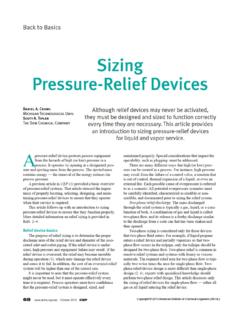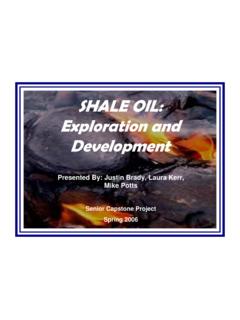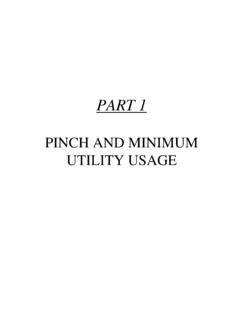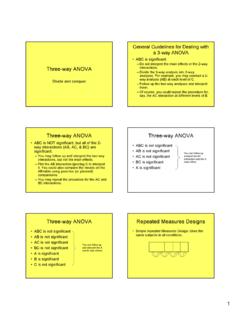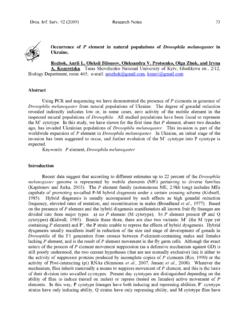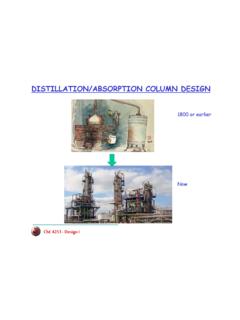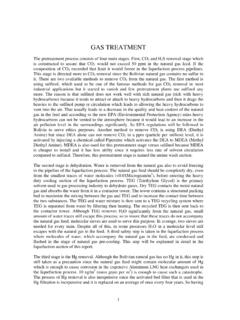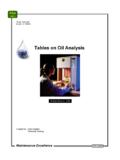Transcription of Overview of Crude Units - University of Oklahoma
1 1 Overview of Crude Units Crude Units are the first Units that process petroleum in any refinery. There objective is to separate the mixture into several fractions like naphtha, kerosene, diesel and gas oil. A schematic diagram of an atmospheric Crude fractionation unit is shown in Figure 1-1. CrudewaterHENHENDESALTER sour waterFURNACE steamsteamsteamsteamPA3PA2PA1kerosenedie selgas oilResi due to Vac. Towernaphthawater Figure 1-1: Atmospheric Crude Unit. Crude oil contains salts which can be harmful to downstream equipment and must be removed.
2 To remove the salts, water is mixed with the Crude oil and typically heated to temperatures between about 215 oF to about 280 oF and allowed to separate in the desalter. The desalted Crude enters another heat exchanger network. Both heat exchanger networks make use of the vapors of the main column condenser, the pump-around circuit streams (PA1, PA2 and PA3), and the products that need to be cooled. Then, the preheated Crude enters the furnace, where it is heated to about 340-372 oC (644-700 oF). The partially vaporized Crude is fed into the feed region (called flash zone) of the atmospheric column, where the vapor and liquid separate.
3 The vapor includes all the components that comprise the products, while the liquid is the residue with a small amount of components in the range of gas oil. These components are removed from the residue by steam stripping at the bottom of the column. Products are withdrawn from the side of the column and side strippers are used to help controlling the composition of light components. In addition, to more effectively remove heat, liquid is extracted at various points of the column and cooled down to be reinjected at a different position on the column.
4 Cooling water and sometimes air coolers are used in the heat exchangers PA1, PA2 and PA3, but it is always more advantageous to have these streams release their heat to the raw Crude oil in the heat exchanger networks (HEN), usually called pre-heating 2trains. Several different designs and configurations for the heat exchanger network in the conventional Crude oil distillation unit are possible. Figure 1-2 shows one particular instance of a preheating train, not necessarily the best or most recommended one (efficient ones are discussed later).
5 In addition, in some oil distillation Units , gas oil is not produced and instead becomes part of the residue. Such Units contain one less side-stripper and one less pump-around than those shown in Figure 1-1 and Figure 1-2. Further, in Units in which gas oil is not produced, the diesel may be further separated into heavy and light diesel. Figure 1-2: Atmospheric Crude Unit-with preheating train. The topped Crude leaving the atmospheric tower still contains significant amount of valuable oils. These oils cannot be distillated at atmospheric pressure because the temperature required would be so high that severe thermal cracking takes place.
6 Figure 1-3 depicts such a unit. Note first that this unit does not have a condenser and does not feature side strippers either, simply because products do not have specifications on their light end. However, side strippers can be used in specific cases, such as lube base oil production. 3To EjectorsVLGOVHGOV acuum ResidueVacuum FurnaceTopped Crude Figure 1-3: Atmospheric Crude Unit-with Preheating train. Figure 1-3 shows that light vacuum gas oil (LVGO) and heavy vacuum gas oil (HVGO), are produced. Sometimes, depending on its properties, LVGO is blended with other products like atmospheric diesel.
7 Both are typically used as feed to fluid catalytic cracking Units . The vacuum distillation consists of the vacuum furnace, vacuum tower and the vacuum producing system. The topped Crude is heated up in the vacuum furnace to about 400 C. The temperature is controlled to be just below the temperature of thermal decomposition. Although a single cut of vacuum gas oil (VGO) is allowed in some cases, drawing LVGO and HVGO separately is more beneficial from the point of view of energy savings, because the resultant HVGO draw temperature is 90-120 C higher than the corresponding draw temperature of a single VGO cut.
8 Lighter components are removed from the residue by steam stripping. In addition coke formation is reduced by circulating partially cooled bottoms to quench the liquid to a lower temperature. Because the heavy Crude fraction contains metal complexes (asphaltenes and porphyrines), which are catalyst poisons for downstream processes, sometimes a recirculation of wash oil in the bottom part (not shown in the figure) is included to prevent these compounds to reach the HVGO. Vacuum distillation is widely used to produce catalytic cracking plant feed stocks of low carbon content.
9 It is also used to produce lube oil fractions. In practice, the uses of vacuum distillates and residue depend on the type of Crude oil feed, the type of refinery and its downstream processing capacities. The major specifications for the most common products are (Watkins, 1979): Catalytic cracking feedstock: Gas oils for catalytic cracking feedstock require a strict separation between distillate and residue. The amount of carbon content in these oils should be minimal while not sacrificing gas oil recovery. This is necessary to reduce 4coke forming on the cracking catalyst.
10 The metals content, particularly vanadium and nickel, should be controlled because they are severe catalyst poisons. Hydrotreaters or Hydrocrackers Feedstock: These can tolerate a slightly higher metal content because the hydrogenation catalysts contain these metals. However, the amount of carbon and asphalt materials should be minimal to prevent coke formation. Distillate fuel oils: Distillate fuel oils to be used directly are specified by API gravity, viscosity, metal content and flash point. Atmospheric boiling ranges can be used to define the separation.
